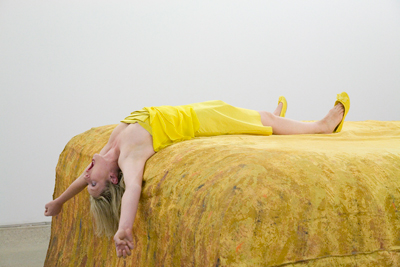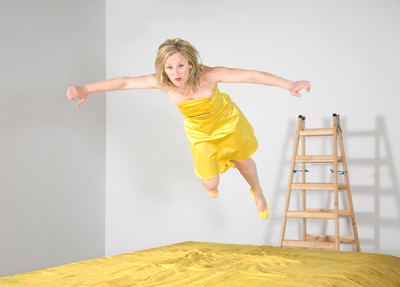…enunciating soundless words, the performer lies supine, head and shoulders hanging over the edge of the protective cushion, arms outstretched. Handel’s We shall purify swells in the background, recedes. She rolls from the cushion to the floor. Dragging her hand delicately and almost resignedly across the surface of the mat, she walks around and climbs the ladder. She adjusts her clothes, her hair, in preparation, steadies her mind. Pause. And then. Leap. Repeat…

There is something very different about encountering performance art. It engenders an awareness of physicality in the viewer in a way that no other art practice can – it questions one’s own relationship to the self and to the other – negotiated through the corporeal.
Amanda Coogan’s performance in Kevin Kavanagh featured a number of devices that seem to recur in her work. What struck me first is the attention to the aesthetic of the performance, particularly the detailed and immaculately constructed garment Coogan wore. This thread continued in the photographs that were exhibited. The pure workmanship and beauty of the garments Coogan wears in her performances indicate that there is an investment in the language of clothing. Cheong Sam for the machine gun [1], pleated yellow strapless dress with a train, as though to enhance the quality of flying.

Coogan’s physical repertoire consists of the banal as well as the sublime. There was a deliberate adjusting of the ballet slippers which persistently came loose and of the strapless dress that slipped down occasionally. This was undertaken in a way that acknowledged the everyday-ness of these gestures but without it seeming accidental. The performance conflated the polarities of the intellectual artistic performance gesture with the self-conscious adjustments of garments and accoutrements that one might perform ordinarily. In this way, the performance allowed the audience in – this everyday-ness allowing for the viewer to identify with the body of the performer.
Inevitably, references to other iconic performances are present here, the obvious one being the famous Yves Klein Leap into the void which was cited in the statement. Coogan’s was less of a leap: there was not the illusion of abandon here – it felt far more tentative. The title of the work is The Fall – emphasising the inverse of a leap, it’s terrifying consequence. This said, the central activity here seemed to be the prelude to the titled event, the preparation of body and mind for the action of falling.

The presence of the ladder directed my mind to Chris Burden’s performance 220 [2] and implied the sense of danger and apprehension experienced when forcing oneself through a series of activities that place the body in jeopardy. Which leads to the next uncomfortable impression about this performance, which is of the pain that Coogan is surely inflicting upon her body and the stamina and control she asks of her physical self over the course of four hours of repetitive action.

This performance caused me to consider again the debated notion of the body as a vehicle for consciousness, like an implement for the intellect. Elizabeth Grosz describes this more articulately in the context of the debate about the devaluation of the corporeal and sexual politics.
the body is commonly considered a signifying medium, a vehicle of expression, a mode of rendering public and communicable what is essentially private (ideas, thought, beliefs, feelings, affects). As such, it is a two-way conduit: on one hand, it is a circuit for the transmission of information from outside the organism, conveyed through the sensory apparatus; on the other hand, it is a vehicle for the expression of an otherwise sealed and self-contained, incommunicable psyche. It is through the body that the subject can express his or her interiority, and it is through the body that he or she can receive, code, and translate the inputs of the the “external” world. (Volatile bodies: toward a corporeal feminism, Elizabeth Grosz, p 9)
In The Fall there was a real sense of considered and intellectual control over every movement of the body; there was an incredible discipline and unnerving mental focus. This had the effect of causing the viewer to pause to consider every movement and nuance of their own physicality in response. The implication of this is as Grosz describes – the body is posited as a conduit for the interiority of the subject on one hand, and on the other a site for projection for the ‘external world’ of the audience. Throughout the course of the performance there was a sense that the gallery bristled with people readjusting their bodies, becoming suddenly and unbearably aware of them. It is as though every corporeal expression constructs meaning for Coogan and has the reflexive effect of making the viewer confront the meanings we create (consciously and subconsciously) with our own bodies.
…enunciating soundless words, the performer lies supine, head and shoulders hanging over the edge of the protective cushion, arms outstretched. Handel’s We shall purify swells in the background, recedes. She rolls from the cushion to the floor. Dragging her hand delicately and almost resignedly across the surface of the mat, she walks around and climbs the ladder. She adjusts her clothes, her hair in preparation. Steadies her mind. Pause. And then. Leap. Repeat…
Barbara Knezevic is an artist and Circa’s administrator.